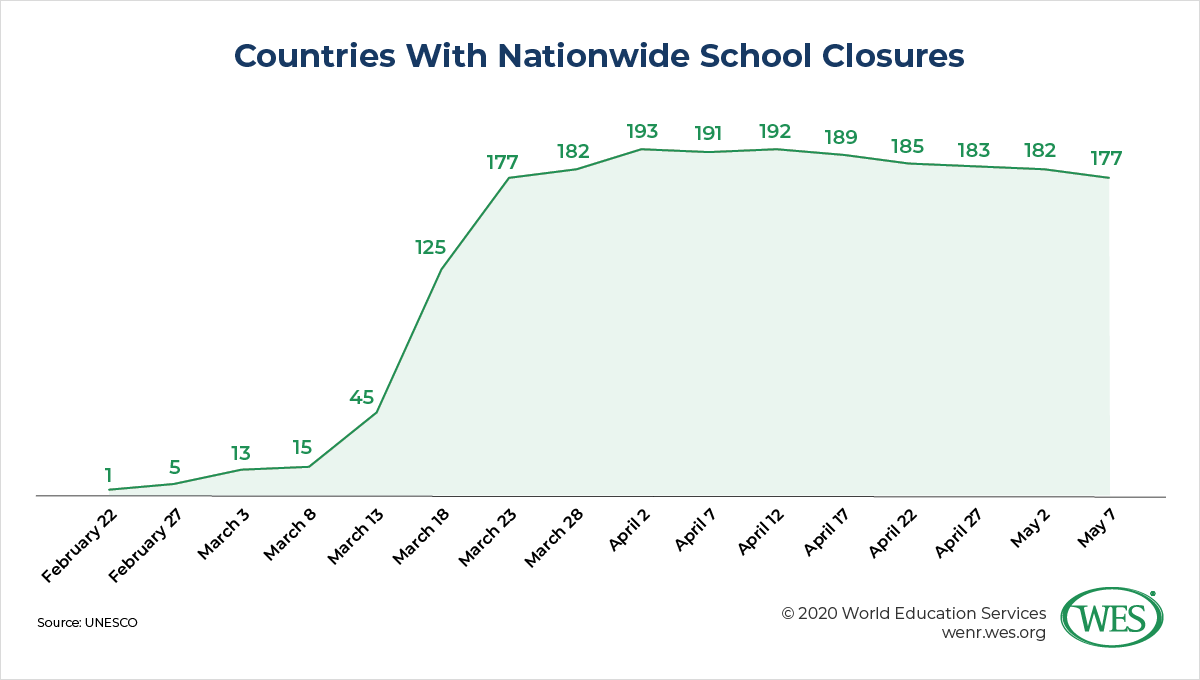Stefan Trines, Research Editor, WENR
In the history of global education, 2020 will go down as the year the coronavirus pandemic savaged education systems worldwide, closed schools in 192 countries, and locked more than 90 percent of enrolled learners out of classrooms globally [2]. It will be remembered as a year of chaos, makeshift solutions, uncomfortable compromises, and, quite possibly, a few questionable decisions.
To keep education going amid the pandemic, many countries and institutions are currently suspending their regular academic standards and procedures. Admission thresholds are being lowered to allow students unable to take admission tests to enroll. Graduation requirements have been eased, so that students can earn degrees without sitting for exams. Accreditation protocols and campus inspections have been adjourned, while an unprecedented number of institutions have shifted to remote learning without instructors nor students being prepared for the change.
Given the literal life-and-death implications of the pandemic, it’s understandable that governments are taking unprecedented steps to protect their citizens, students, parents, and institutions from harm. For many institutions, suspending normal academic standards is a matter of self-preservation, to stave off financial ruin by retaining at least a bare minimum of students, and consequently, revenues. On the upside, the crisis may accelerate some positive innovations at academic institutions.
On the other hand, some emergency responses have raised concerns about the erosion of quality standards, as well as the responses’ social fairness. Outpaced by the pandemic, many governments are improvising, hastily revising practices without any in-depth policy analysis. It’s not unreasonable to ask if all stakeholders will revert to regular standards once the pandemic subsides, or if some of the compromises made now will become part of a “new normal”.
Consider that the higher education sector will face crippling financial constraints in the years to come, making the path of least resistance a tempting proposition during the difficult recovery period that lies ahead. Countries with weak quality assurance mechanisms may find it even harder than before to enforce quality standards amid intense fiscal pressures. The rapid shift to remote learning all over the globe will raise questions about academic quality and necessitate the development of new quality assurance mechanisms for distance education programs in various countries. Caught in the middle are the world’s students, trying to pursue their academic careers under extremely difficult circumstances.
Given the importance of all these developments for societies worldwide, this article provides an overview of some of the steps education systems are taking to accommodate lockdowns and the demands of social distancing, as well as a brief discussion of the social implications of these changes.
Admission Standards
Social distancing upended secondary school leaving examinations and university entrance tests worldwide, disrupting the admission of new students for upcoming academic terms. Because of differences in academic calendars and epidemic peak periods, not all countries have been affected equally. For instance, the one-month delay of China’s gaokao, the world’s largest university entrance exam, is unlikely to affect the admission prospects of the more than 10 million students expected to sit for the exam in July [4].
But other countries have been affected more severely. To name but a few examples, the British government in March canceled the GCSE, AS, and A level exams, originally scheduled to take place in June; while the West African Examinations Council indefinitely suspended [5] the high-stakes West African Senior School Certificate Examination, the main secondary school leaving qualification in five countries, including Nigeria. In another example, the United States canceled the SAT standardized tests [6], required for admission by more than half of U.S. higher education institutions (HEIs), especially prestigious universities [7].
In many ways, these steps constitute an emergency response to the benefit of students —a compromise that prevents students from losing a year of their academic careers to social distancing. That said, policy makers need to weigh the possible unintended consequences of such compromises. Consider that some of the graduating high school classes of 2020 may end up blemished and bruised as “easy entry” student cohorts, especially in competitive meritocratic systems that value examinations and other formal performance criteria as selection mechanisms for access to scarce university seats.
What’s more, the suspension of selection criteria doesn’t necessarily make access to education more equitable. As noted by Angel Pérez, vice president for enrollment and student success at Trinity College, in the U.S. context, “when rich students have school counselors, test prep tutors, and independent education consultants to proactively provide solutions to the cancellations of SAT and ACT test dates, low-income students will have to scramble to find information and develop alternative plans [8]. … The March SAT is a prime example of the unequal access to testing and its disparate impact on communities. As large urban districts closed all schools and canceled SATs, some private schools held their March SAT [8].”
Such concerns about social fairness are echoed by U.K.-based education experts, many of whom maintain that predicted A level exam grades—currently slated to be used for admission in lieu of actual scores—disadvantage students from low-income households. Research has shown that predictive grades accurately reflect final exam grades less than 20 percent of the time [9], and may also underestimate the test performance of top students from disadvantaged social backgrounds. Put differently, high-performing students from low-income households may be—unintentionally or not—among the losers of the U.K.’s pandemic emergency response.
There are also concerns that the suspension of competitive student selection mechanisms could alter the structure of university systems. The U.K. government, for instance, is considering imposing admission quotas to prevent top universities, now freed from the constraints of normal admissions standards, to compensate for dwindling international student numbers by “hoovering up” larger numbers of domestic students—a move that could jeopardize the financial viability of less prestigious institutions [10].
The potential for a shake-up and consolidation of the U.K. university system illustrates that emergency responses to the coronavirus pandemic could have some unintended consequences, negative or positive, that outlast short-term responses to the crisis. Universities in countries that have centralized admissions processes, for instance, may introduce their own institution-specific university entrance examinations in lieu of suspended nationwide selection mechanisms.
India’s University Grants Commission, meanwhile, has suggested the opposite. It proposed that universities hold joint admissions examinations [11] to make it easier for students to apply to multiple institutions amid travel restrictions—a recommendation that could lead to a standardization of admissions procedures, similar to the unified admissions process that was recently developed in the field of medicine [12].1 [13]
Easing Promotion and Graduation Requirements
As noted, the suspension of face-to-face instruction in most parts of the world has created pressures to promote and graduate students without examinations or other regular requirements. While the most common approach thus far has been to postpone exams, countries like Norway [14], Indonesia [15], and France canceled examinations outright, opting to promote students based on criteria like average scores in school subjects “calculated from marks given for tests and homework throughout the year [16].” The International Baccalaureate (IB) is taking the unusual step of awarding the IB diploma based on “data analysis from previous exam sessions,” school performance data, and the external grading of coursework provided by schools [17].
Meanwhile, universities in Canada, the U.S [18]., and other countries are suspending standard grading practices for the current term, assessing students on a pass/fail basis, or adopting other flexible approaches, such as allowing students to choose credit/no credit options [19]. There is an equity dimension to these changes. When coursework and exams are moved online, low-income households are disadvantaged, since they disproportionately lack access to computer devices or internet connections, particularly in developing countries. Compared with their richer peers, these students are more likely to live in environments unsuitable to learning, they may have to share devices with family members, and so on.
Considering these realities, student organizations in the Philippines and elsewhere have demanded that universities promote students with lenience rather than continue classes online. Student unions in several African countries urged universities to stop online exams amid digital divides and called for the boycott of “elitist” remote learning solutions [20]. While distance education can help expand access to education [21] in overburdened education systems with capacity shortages, shifting learning online in its entirety has severe social ramifications in countries with wide wealth disparities.
However, there are other issues to consider. It’s inevitable that some will view switching to pass/fail grading scales or graduating students without exams as steps that penalize high-achieving students, or that are unfair to student cohorts of other years. As one U.S. student put it, the “pass/fail system is a disgrace to students who have worked hard for their A’s. For me, this is my best semester, and the pass/fail system takes away my GPA, which I need for internships and many other career opportunities [22].” There are various potentially negative implications for students down the road—from limiting transfer credit options [23] to curtailing admission prospects because “their transcripts will be looked upon less favorably when they apply to graduate or professional school [24].” In the extreme, in countries that emphasize final examinations for the awarding of degrees, qualifications may be tarnished as “easy degrees.”
Quality Assurance
The compromises necessitated by the crisis are manifold. Consider that the U.S. waived examination and practice requirements to issue temporary emergency licenses to physicians, [25] nurses, and other health professionals [26], while China waived licensing requirements for teachers and allowed them to start teaching without having passed required exams. Accreditation and licensing requirements for academic institutions were likewise suspended in different countries. The U.S. Department of Education, for instance, permitted accreditation agencies to extend accreditation terms, conduct virtual site visits, and bestow retroactive accreditation. According to the department’s guidelines, students graduating from a program with pending accreditation due to outstanding site visits are to be “considered to have graduated from an accredited program [27].”
While most of these measures are expected to be temporary, the rapid and large-scale shift to online education is of greater concern from a quality perspective. Across the globe, academic institutions have abruptly switched to distance learning—without curricular planning, adequate learning materials, or teachers trained to deliver education remotely. Programs originally accredited as regular on-site programs are now being run in distance education mode. It can also be expected that increasing numbers of “snack-sized [28]” micro credentials and unregulated online programs will pop up worldwide.
Since it’s unclear how long the coronavirus pandemic will last and to what extent distance education will become more ubiquitous, it’s important that governments and quality assurance bodies adapt quickly to ensure that the new distance learning programs are of equal quality to regular programs on-site. This is not a trivial task. Recent studies from Australia, for instance, maintain that the current shift to distance education will have major negative impacts on learning outcomes [29]. The rapid proliferation of distance learning courses raises other questions as well, such as the increased potential for cheating during online examinations
To assure admissions officers, credential evaluators, licensing boards, and other stakeholders that there are robust quality assurance mechanisms in place to assess distance learning programs, it might be helpful if academic institutions and quality assurance authorities develop an informational leaflet akin to the European Diploma Supplement [30]. Provided alongside academic documents for distance learning programs, such a supplement could help assure recipient institutions that distance mode versions of academic programs have at least the same admissions and graduation requirements, curricula, and assessment criteria as regular on-site programs.
1. [31] Entrance examinations in disciplines like engineering are already centralized as well.
The views and opinions expressed in this article are those of the author(s) and do not necessarily reflect the official policy or position of World Education Services (WES).


